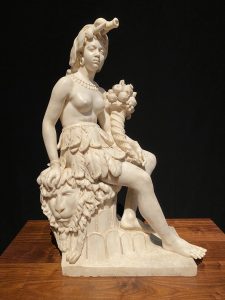 Randolph Rogers (American, 1825–1892)
Randolph Rogers (American, 1825–1892)
marble
31 7/8 x 16 3/4 x 10 1/2 in. (81 x 42.5 x 26.7 cm)
McGuigan Collection. Artwork in the public domain.
American sculptor Randolph Rogers is best known for his 1855 commissioned reliefs on the doors of the U.S. Capitol, which included one of the earliest examples of a person of African descent in American sculpture. It is probable that this sculpture predates the Capitol commission. Kneeling before the viewer, the allegorical representation of Africa wears and holds material symbolism alluding to her association with the continent: an elephant headdress, coral necklace, gold hoop earrings, and a bountiful cornucopia. Unlike this example, most representations of “Africa” did not always contain African features. Here, the broad nose and full lips indicate that Africa is depicted as a Black woman. The figure’s facial features and thoughtful expression are highly individualistic, suggesting that Rogers likely sought a model of African descent to render the face.